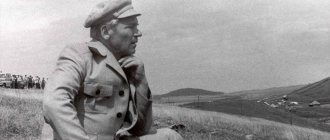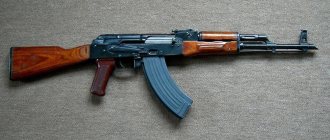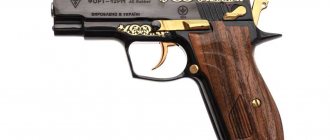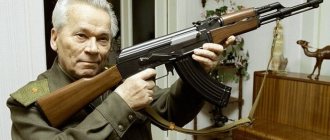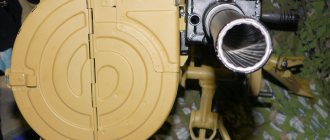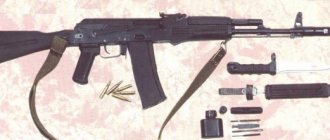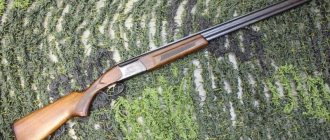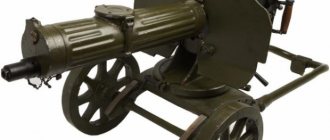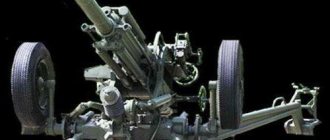Who knows the history of the Kalashnikov assault rifle? But this is a legendary machine gun, used by most countries around the world. It is not only one of the most popular small arms, but also one of the most significant inventions of the twentieth century. During the existence of the AK-47, more than fifty million modifications of this machine gun have already been produced. A legendary weapon that has received recognition from most countries of the world. The history of the creation of the Kalashnikov assault rifle will be told to the reader in the article.
Creator of the AK-47 small arms gun
Who invented the Kalashnikov assault rifle? This was done by the famous weapons designer and developer - M. T. Kalashnikov. Being a lieutenant general, he was also a Doctor of Technical Sciences, in Soviet times he was a member of the CPSU, a participant in military operations, winner of many medals, awards and orders, a public figure, a deputy who received the title of Hero of the Russian Federation.
Mikhail Timofeevich Kalashnikov is a native of the Altai Territory, born into a large, large family on November 10, 1919. From an early age he was interested in studying the action of various mechanisms. Once, after graduating from school, the young man independently disassembled a Browning pistol in order to familiarize himself and study the weapon in detail.
Upon reaching the age of 19, he was called up for military service, where he received the specialty of a tank driver.
Mikhail Timofeevich Kalashnikov began to show his inventive talent during his service. One of his first developments was an inertial recorder that counted the number of shots fired from a tank's cannon. Then for several months he was fascinated by the development of a tank engine life meter. The result exceeded all expectations - the invention worked accurately, accurately recording the operation of the engine.
During the Great Patriotic War he was a tank commander, but in the fall of 1941 he was seriously wounded. It was during treatment that he began to make the first sketches of automatic weapons. He developed his idea, taking into account his own impressions received during the battles, studied specialized literature, and listened to the opinions of his colleagues. This activity captivated the talented young man so much that within a few months he developed his first model of firearms. Although the submachine gun sample was not recommended for mass production for a number of technical reasons, the great Soviet scientist in the field of mechanics A. A. Blagonravov noted the originality of the idea, as well as the design of the sample itself.
Kalashnikov began developing the assault rifle in 1945. After several years of design, modifications, and combat testing, Kalashnikov automatic systems were adequately assessed and recommended for army weapons. For the greatest development of national importance, the one who invented the Kalashnikov assault rifle received the Stalin Prize of the first degree, and was also awarded the honorary Order of the Red Star.
Stages of the long journey
Experts went towards creating the Kalashnikov assault rifle in several stages: a huge number of competitions were held, during which various less successful systems of many authors were eliminated. In 1944, the AS-44 assault rifle, developed by A. I. Sudaev, was recognized as the most successful. It was produced in a limited edition for further military testing throughout the spring and summer of 1945. The machine performed well, but there was only one snag: the management insisted that the weight of this model be further reduced.
Unfortunately, at the age of 33, this talented design engineer died suddenly, and the search for the ideal weapon in the person of this model was suspended after the loss of the ideological inspirer and brain center of the project. But it was impossible to stop the search, so a month later another round of tests was carried out, to which Mikhail Timofeevich Kalashnikov joined at that time.
Development history
In what year was the Kalashnikov assault rifle created? In 1943, a rifle cartridge, the caliber of which was 7.62 mm, received for armament, required small arms. The development of weapons specifically for a cartridge of this caliber began on a competitive basis. The main task was to surpass analogues and create a worthy replacement for the Mosin rifle.
Among the competition entries were other successful projects by well-known developers, but Mikhail Kalashnikov's automatic system (also known as the AK-47) outperformed its competitors in design as well as production cost.
In 1948, Mikhail Kalashnikov went to the motor plant in the city of Izhevsk to produce a trial batch of automatic systems in order to test them through military tests. A year later, serial production of the AK-47 started at the machine-building plant in the city of Izhevsk. By the following year, the AK entered service with the army of the Soviet Union.
"The party said 'We must!'"
In the early years of World War II, for obvious reasons, the development of military weapons was given priority throughout almost the entire world. This issue was given particular importance in the Soviet Union: the invention of a fundamentally new model, superior in characteristics to everything that was available until then, promised a significant advantage at the front.
At the People's Commissariat of the USSR, technical councils were periodically held, at which the further direction of work of domestic designers was determined.
This area was under the control of the Supreme Commander-in-Chief, so the stakes were high and mistakes could be fatal not only for individual military ranks, but also for entire design bureaus or institutes involved in this area.
July 1943 was a turning point for the Soviet army: on July 5, the next offensive operation of the German army began, which contemporaries know as the “Kursk Bulge”. Tension in the highest echelons of power reached its limit, which forced active action in all areas of the military industry, including weapons design.
On July 15, a meeting of the Technical Council was convened. It examined a captured German-made MKb.42(H) machine gun and an American M1 Carbine carbine, which had been studied by experts. Both of them had a certain characteristic that interested specialists: they were designed for intermediate cartridges. Intermediate cartridges are those cartridges whose caliber is between a pistol and a rifle.
The Technical Council came to the conclusion that this direction is very promising, and Soviet design bureaus are obliged to provide developments of domestic intermediate cartridges and corresponding weapons as soon as possible. The task was urgently transferred to numerous development bureaus, and work immediately began to boil.
Design
Main parts of the AK, their purpose:
- A rifled barrel of an assault rifle, including a bullet entrance, as well as a chamber. Directs the flight of the bullet.
- The receiver is designed to connect the mechanisms into a single structure.
- The butt contains a specially created socket where a pencil case with tools for cleaning the weapon is placed.
- Sights, consisting of a sector sight and a front sight, are necessary for direct control of the location of the barrel channel relative to the aiming point. They are used to point the firearm at the target while firing. The position of the front sight is easy to change to adjust the location of the midpoint.
- The cover (removable) of the receiver prevents damage to the internal mechanisms.
- The bolt carrier, connected to a gas piston, is one of the main elements of a firearm, actuating the bolt element and also triggering the trigger mechanism.
- The bolt closes the barrel channel before firing. Advances the cartridge from the magazine directly into the chamber. There is also a special mechanism on the bolt, with the help of which the spent cartridge case or cartridge is removed from the chamber (if a misfire occurs).
- The return mechanism, thanks to a special spring, returns the bolt frame to its extreme forward position.
- A gas tube with a barrel lining regulates the direction of movement of the gas piston using directional ribs.
- The trigger mechanism includes a trigger, a spring trigger retarder, a trigger, an automatic spring release, a sear, and a translator. Provides de-cocking and switching from single to continuous fire. Using this mechanism, you can stop shooting and also fix the safety.
- The handguard is necessary for comfortable holding of the weapon during combat shooting; it serves the function of protecting hands from contact with hot metal, thereby preventing burns.
- The magazine is box-type and holds three dozen rounds. Thanks to the spring, the cartridges move directly into the receiver.
- The bayonet-knife is attached for use during close combat.
- The muzzle brake is a special compensating device designed to increase the stability of the weapon during a shot. Partially removes powder gases when firing, thereby significantly reducing barrel recoil. Helps increase accuracy when firing in bursts (appeared in the AKM version).
Most young men can easily list the main parts of an AK-47, since assembling a machine gun in a certain time is a mandatory part of the school course of military basic training.
The total number of AK elements is about a hundred parts.
Specifications
The first version of the AK-47 was distinguished by the following main characteristics:
- The weight of the Kalashnikov assault rifle is 4.8 kg (not including the bayonet).
- The length of the automatic system was 870 mm (including the knife - 1070 mm).
- The bullet speed of a Kalashnikov assault rifle (initial) is 715 meters per second.
- Barrel caliber – 7.62 mm.
- Cartridge – 7.62 x 39 mm.
- The Kalashnikov assault rifle magazine consists of thirty rounds.
Rate of fire:
- when firing in bursts - 100 rounds in one minute;
- when firing single cartridges - 40 rounds in one minute;
- technical rate of fire is approximately 600 rounds per minute.
Shooting performance:
- maximum bullet flight – 3 km;
- lethal shot range – 1500 meters;
- direct shot range – 350 meters.
Start of development
The pioneers were the designers of OKB-44, who within a month developed the requested cartridges. Initial testing lasted six months, after which pilot production began in March 1944 in order to identify all problems and shortcomings through mass testing.
In parallel with this, in the fall of 1943, the created drawings were sent to other design bureaus that were assigned this task. The suitable cartridge designed by Elizarov and Semin was initially presented in a caliber of 7.62x41 mm, but after joint revision it changed to 7.62x39 mm.
According to the instructions of the Technical Council, the new type of weapon being developed was to be a combination of an assault rifle, a carbine and a light machine gun.
This new product was supposed to provide the ability to accurately fire at a distance of 400 m, which would make it possible to replace the bulk of individual infantry small arms with new and better ones.
Modifications
The history of the Kalashnikov assault rifle contains information that the very first version designed by Mikhail Timofeevich during the competition was the AK-46. This version of the weapon was invented in 1946, but after detailed study and a series of combat tests, this model was found unsuitable.
However, as the history of the creation of the Kalashnikov assault rifle tells, the next year, 1947, was the year of development of the famous AK-47.
Together with the AK, by 1949, the Soviet Army adopted a folding version of the AK - AKS, created for special forces.
Then, since 1959, the history of the Kalashnikov assault rifle moves to a new stage. The AK-47 is being replaced by the modernized Kalashnikov assault rifle (AKM). From the same year, it was the AKM that became the most common version of the Kalashnikov. Compared to previous models, the AKM has improved firing range, the shape of the butt has been changed, a muzzle brake-compensator has been added, the weight has also been reduced, and a bayonet has been added. Along with this model, a modification of the AKMN was released, which has a night optical sight.
Together with the AKM, the armament was replenished with a similar model, but the stock of which is folding - AKMS. In addition to this version, there was also AKMSN, that is, a night version with a special optical sight.
Over the next few years, the development of an automatic system for use with a 5.45 x 39 mm cartridge was actively underway. By 1974, a new modification entered service - the AK-74 and AK-74N (a model that includes a night sight and an optical sight). A special development for special forces was a new version of the AKS-74, that is, a model with a folding stock, another model was called AKS-74N - a night modification with an optical sight.
By 1979, a shortened version of the AKS-74 - AKS-74U and AKS-74UN, containing fasteners for a night and optical sight, appeared specifically for arming airborne troops.
In 1991, a modernized AK-74 called AK-74M entered service with the army. The unique machine, released into mass production, managed to replace several models at the same time.
It was the AK-74M version that became the base version for the development of the entire 100th series.
The 100th AK series represents various versions of the AK-74M, designed for export. For deliveries to other countries, only automatic systems of the 100th series are now used, since this series is superior to the previous ones in the quality of the material, the modernity of the technological process, and improved shooting characteristics.
The newest modern fifth-generation model is the AK-12 model. This sample appeared in 2012.
Background and history of the creation of the AK-47 assault rifle
At a meeting of the Technical Council at the People's Commissariat of Defense of the USSR, held on July 15, 1943, it was decided to create an intermediate cartridge similar to the cartridge of the German Haenel Schmeisser assault rifle and, accordingly, weapons for it.
The main reason for the creation of new small arms was the need to equip infantry with weapons for effective shooting at a range of up to 400 meters, which was inaccessible to existing submachine guns.
Already in November 1943, technical documentation appeared for a new intermediate cartridge of 7.62 mm caliber designed by N. M. Elizarov and B. V. Semin. The cartridge had a caliber of 7.62x41 mm, but was subsequently changed to a caliber of 7.62x39 mm. The development of weapons for the new cartridge consisted of several stages and competitions, in which samples from various designers took part.
So, in 1944, after successful tests, the AS-44 assault rifle designed by A.I. Sudaev received approval. After modification, the weapon was released in a small batch and transferred to some military units for practical use, but the army leadership remained dissatisfied with the large mass of weapons.
In 1946, another round of tests took place, in which the little-known weapons designer Mikhail Kalashnikov took part. In November of the same year, his machine gun project received the go-ahead for production of a prototype. A month later, the first version of the AK was presented for testing. The machine gun turned out to be more than reliable and had a minimum number of parts, was easy to use and could withstand up to 100 thousand shots.
The new weapon was immersed in water, soaked in muddy mud, tied to equipment and dragged along country roads. And even after that the machine worked like a clock.
The classic and very first AK-47, made of iron and wood and without any bells and whistles, became a symbol of reliability and simplicity, the ideal weapon, for many years. But, before becoming such, its original version, the AK-46, underwent a number of changes.
First of all, members of the selection committee demanded that the location of the cocking handle be changed from left to right, so that the handle would not interfere with the soldier while carrying a weapon or crawling. Another condition was to combine the safety with the fire type translator into a single group and place it on the right, so that the left side of the weapon, in contact with the shooter’s body, would get rid of all sorts of protrusions.
By the winter of 1947, at the next round of the competition, Mikhail Kalashnikov presented an essentially new machine gun. The test results clearly showed that not a single weapon sample, presented together with a Kalashnikov assault rifle for the competition, satisfies the stated requirements. The creation of Mikhail Kalashnikov turned out to be the most reliable, although it did not have great accuracy of fire. As a result, the selection committee chose the sample of Mikhail Kalashnikov.
On January 21, 1948, an order was issued by the Minister of Armaments of the USSR Dmitry Ustinov on the production of the first experimental batch of AK-47 in the amount of 1,500 pieces. And on June 18, 1949, by a Decree of the Council of Ministers of the USSR, the 1947 model Kalashnikov assault rifle was adopted by the Soviet Army.
AK outside Russia
Within a few years of the AK-47's adoption, production licenses were granted to approximately two dozen countries. The license was transferred mainly to states that were allies under the famous Warsaw Pact. Also, by that time, more than a dozen countries began to produce AKs without the appropriate license.
There are about 100 million different variations of the Kalashnikov assault rifle around the world.
Country of Soviets
The fact that the machine gun turned out to be so successful is not surprising: during the design work, Mikhail Timofeevich Kalashnikov constantly turned to ordinary soldiers for advice, like himself before. This helped to take into account all the nuances, remove the main shortcomings and make your creation as easy to use as possible. This, in the opinion of the developer himself, was the reason why the machine gun turned out to be so reliable: it can fire without fail after being taken out of the ground, from a swamp, after falling from a height to the ground, etc. Its design is extremely simple, but sometimes it is more difficult to make something simple than something clever.
Unfortunately, constant work at training grounds and shooting ranges led to the fact that Mikhail Timofeevich began to hear worse. It was not possible to completely restore hearing even much later, after significant developments in medicine in the early 2000s.
Use in battles
The first combat use of the AK occurred during the suppression of protests in the fall of 1956 in Hungary. Then it was a symbol of the Vietnam War and was actively used by soldiers of the Vietnamese People's Army.
However, the rapid spread of the Kalashnikov assault rifle system around the world occurred during the war in Afghanistan, when the CIA actively supplied armed forces with it.
And then, thanks to its reliability and ease of operation, Iraqi soldiers chose the AK-47 instead of the M16 during military operations in their country.
AK as a civilian weapon
Various variants of the Kalashnikov automatic system are very popular among civilian weapons, especially among those countries where weapons laws are quite liberal.
At the time of the appearance of the very first AK models in the United States of America, it was allowed to own automatic weapons. Later, a law was passed prohibiting the sale of such weapons to civilians, but this did not apply to weapons officially registered before 1986. That's why some people still own combat AK models.
As for most countries around the world, the storage of such automatic systems is prohibited by law. Those who own AKs illegally purchase them on the black market. How much does a Kalashnikov assault rifle cost? The price of an AK varies depending on the modification. So how much does a Kalashnikov assault rifle cost approximately? According to unofficial data, the price of an AK on the black market is around $1,000 (about 55,000 rubles).
Eternal Improvement
But the improvements to the model did not end there: in 1949, there were two models, AK and AKS (automatic machine with a folding stock). The stamping technology used in production was imperfect, so there were a large number of defects among the released samples.
Four years later, stamping was replaced by milling, which sharply reduced the number of defective copies. A number of design improvements made it possible to significantly reduce the weight of the product, so it was designated as “Lightweight AK.” A few more years of work allowed the AKM, a modernized Kalashnikov assault rifle, to be introduced into service in 1959, as a more reliable and convenient model.
AK at the present time
Over time, the Kalashnikov assault rifle (weight, dimensions and other technical characteristics were presented to your attention in the article) has been subject to many critical reviews from leading experts, its shortcomings are increasingly discussed, many call the model frankly outdated. During its existence (and this is already more than 60 years), the requirements for weapon systems in general have changed; the modern world, of course, dictates new rules, demanding improvement and modernization.
However, despite the shortcomings discovered over time, the history of the Kalashnikov assault rifle continues. It is rightfully considered a legendary weapon. Having gained a reputation as a simply reliable machine, it will undoubtedly be in deserved demand for a long time. They continue to copy it, improve it, and refine its characteristics. Monuments are erected to the Kalashnikov assault rifle, depicted on coats of arms, considered a symbol of good luck and even depicted on coins. Its recognition occurred all over the world, and, undoubtedly, the AK left an indelible mark on the weapons history of not only Russia, but also most foreign countries.

